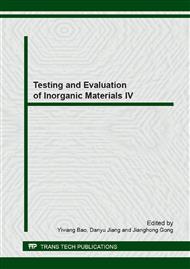p.172
p.176
p.180
p.185
p.190
p.194
p.200
p.204
p.208
Effect of Temperature on Structure and Mechanical Properties of CrN Coatings Deposited by Closed Field Unbalanced Magnetron Sputtering
Abstract:
CrN coatings were fabricated by Closed Filed Unbalanced Magnetron Sputtering (CFUMS). The effect of substrate temperature (TS) on phase components, morphologies and mechanical properties of CrN coatings were studied. The results show that the phase in coatings, which has little to do with TS, was the coexistence of Cr, Cr2N and CrN. The grain shape of the columnar crystal CrN coating was the coexistence of pyramidal and plane topography. The hardness and adhension of CrN coating first increased with the rise of temperature, then decreased when the values of both them were constant ones. It has the highest hardness and bonding strength simultaneously at 300°C.
Info:
Periodical:
Pages:
190-193
Citation:
Online since:
November 2013
Authors:
Keywords:
Price:
Сopyright:
© 2014 Trans Tech Publications Ltd. All Rights Reserved
Share:
Citation:


